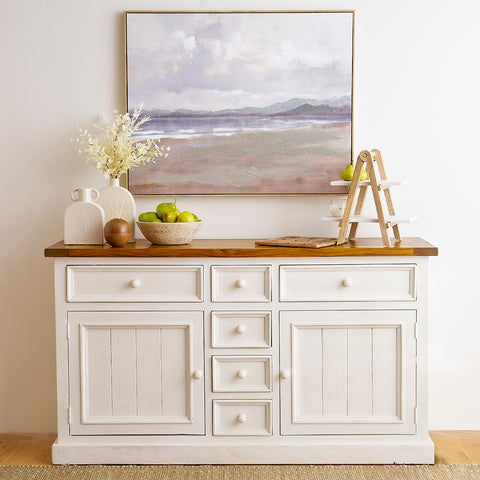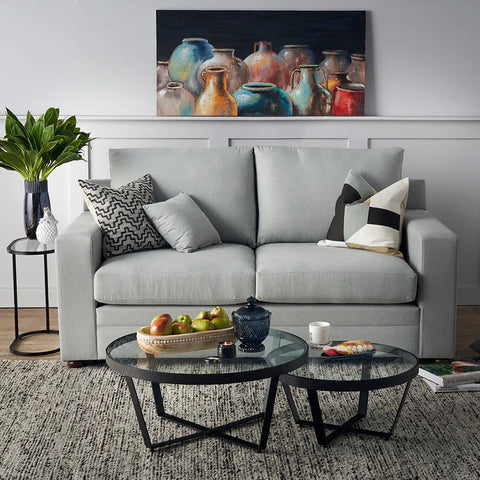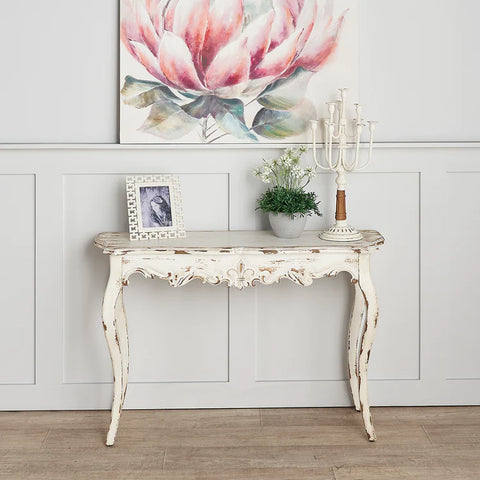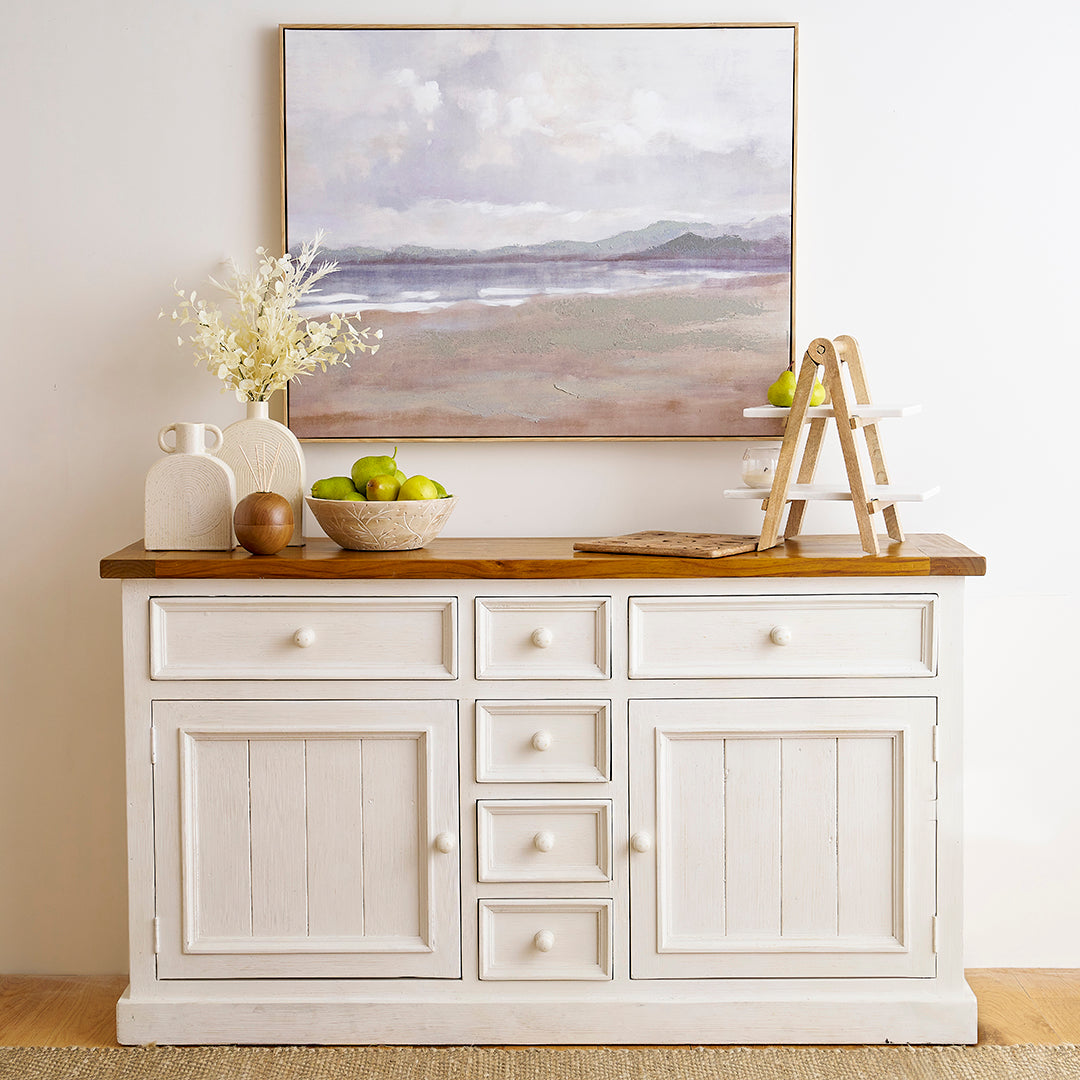The exact formula for hanging wall art is an art unto itself. Sometimes, when you enter a gallery, the artworks themselves do not catch your eye so much as the way they’re arranged. When decorating your home, it pays to tap into your inner gallery curator, even if you’re hanging just one picture. After all, even the loveliest artwork can obscure a room if it’s not suited to its surroundings.
At 1825 Interiors, we want you to get the most out of your wall art. Read on to learn how to hang wall art the right way every time.
Tip #1: Hang your wall art at eye level
When arranging wall art, many fall into the trap of hanging their pieces too high. Of course, you want to take in the room without straining to see the whole picture, so it makes sense to hang your art at eye level. Although all people stand at different heights, the average human eye level will fall about 145 centimetres up the wall. So, when hanging your wall art, a good rule of thumb is to position the centre of each image about 145 centimetres from the floor. This means that you’ll need to affix the hook slightly further up the wall so that the eyes will rest on the 145-centimetre mark.

Image: 1825 Interiors
Sometimes, there are exceptions to this rule. One is when you’re dealing with low ceilings (less than about 2.5 metres tall), in which case you should divide your wall’s longways length into quarters and hang your wall art in the third-most quarter from the floor. Another is when you’re placing art above a couch, in which case you should hang the art 20–25 centimetres above the couch’s back, regardless of the 145-centimetre rule. You should also use your common sense concerning the relationship between your wall art and the point at which your wall hits the ceiling.
Tip #2: Use balance to achieve that ‘gallery’ look
If you want to display a collection of art, here’s your first clue: treat the collection as one piece. Once you’ve shifted your focus from placing each picture, one after the other, to creating a collage, you’ll have a better time seeing the wood for the trees. For each picture to best sing its thousand words, it must coexist in harmony with its neighbours. Each artwork works well on its own, but from this holistic perspective, we’re reframing them to function more as puzzle pieces.
To unlock this harmonic coexistence, simply arrange your pieces from heavier to lighter along a diagonal line: larger pieces in the bottom-left corner and smaller pieces in the top-right. Mid-sized pieces should fall closer towards the middle of this diagonal run. Alternatively, if you’re working with a solar system situation—a few smaller pieces to revolve around one large piece—you should make the large piece the focal point, surrounding it with smaller ‘planets’ 5–13 centimetres apart from their ‘sun’, and one another.
It’s not just the wall art that you should factor into account. Consider how the pieces will fit around your furniture, too. You neither want a large piece crowding out your couch nor a small piece cowering off to the side. When it comes to hanging wall art by furniture, you want pieces that will hit that sweet spot of two-thirds the chest’s or couch’s size.
If your hooks don’t align with our spatial recommendations, never fear! If you need another way to keep the spacing consistent, adhesive tape can work wonders, too.
Tip #3: Do away with hanging altogether
You heard that correctly! If you want an alternate lesson on how to hang wall art, it sometimes pays to do away with the hook, hammer, and nail altogether. For a more time-effective approach, why not empty your floating wall shelves of all books and trinkets and place your wall art there instead? By going hook-free, you’ll have the opportunity to experiment with layering, which can lend a multidimensional aspect to your display. 
Image: 1825 Interiors
If you’re digging the hook-free look, you needn’t necessarily limit yourself to the shelf only. It can also pay to prop a particularly large piece of art against the wall from floor level. So, whether you’re experimenting with floating wall shelves or the actual wall itself, displaying wall art this way can unlock a laid-back, modern look perhaps better suited to a living room setting. By letting yourself off the hook, you can save time and set up a home-style haven rather than a more formal gallery.
Tip #4: Nail the shape and orientation
When it comes to hanging wall art, the hook isn’t the only thing you need to nail. You also need to get the shape and orientation right. What do we mean by this? We mean that when you’re choosing pieces for your wall, you shouldn’t select pieces purely from the perspective of personal preference. You should also consider how shape and orientation will marry with your wall.

Image: 1825 Interiors
Will your choices be a match made in heaven, or will they clash? Here’s a hint for free: if your piece looks more like a speck on the wall than it does a decoration, that’s grounds for a design divorce. You want your wall art to fill out your wall in a way that speaks to its space and alignment, not set it off balance. If the picture is too small, too large, or the wrong shape, take it down and try something new.
Tip #5: Frame wisely
A picture frame can speak as many words as a picture itself. So, if you’re selecting a frame for your wall art, you need to take a discerning approach. There are many styles of frame from which to choose, from monochromatic and modern to ornate and vintage. Just as you would select pieces at the correct orientation and size, you should frame your pieces in a style that matches in theme and colour.

Image: 1825 Interiors
Nailing the art of hanging
As you can see, there’s more to hanging wall art than merely banging in nails and hanging your pieces. You need to also consider the average human eye level, how balance can work wonders, shape, orientation, and framing, and when to forego hooks altogether. Like any other aspect of interior design, how you hang your wall art will depend on the room you’re working with. It’s not just the images that fit together like puzzle pieces—the entire room is your jigsaw, and your pictures should bring out the best in every last one of its pieces.
Will you use your wall art to enhance a space that is vintage, modern, or a postmodern collage of styles? As the gallery curator, the decision is yours. From here, the best course of action is to get a feel for the room in question, choose your pieces accordingly, and—finally—work that wall art to its full advantage. Now you know our top-five tips, we’re sure you’ll nail it!

